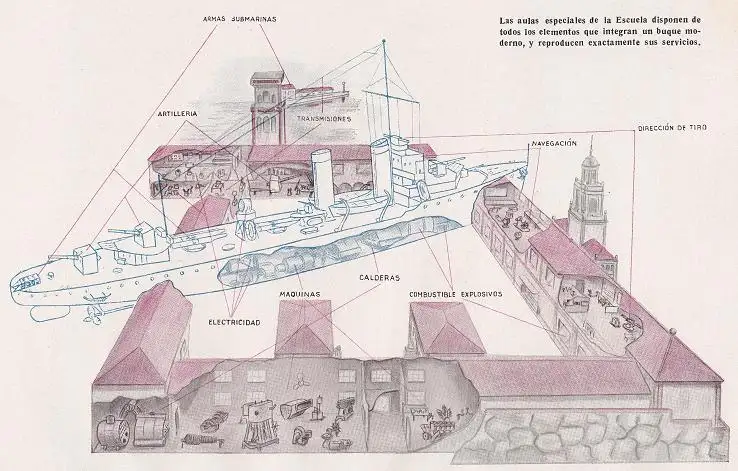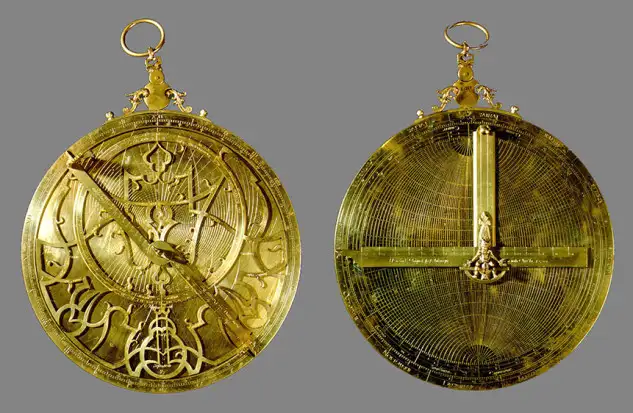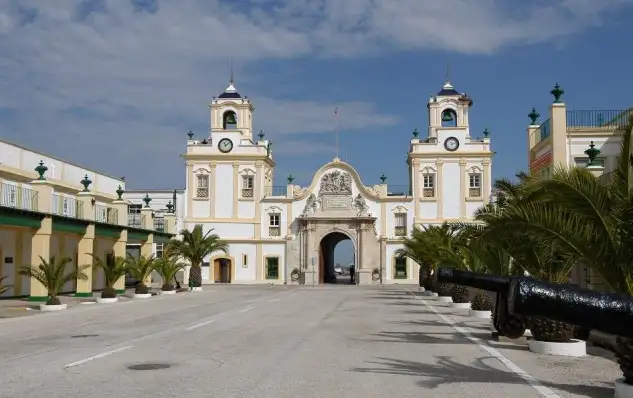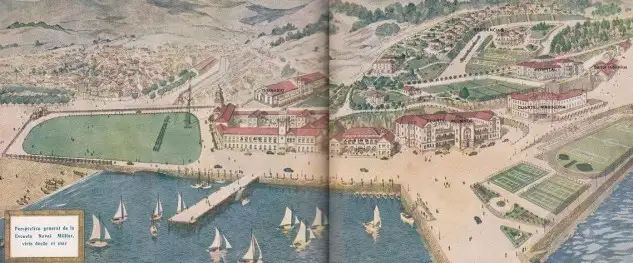
Background and History of the Navy Academies
Background and History of the Navy Academies
Spain, which since the 16th century had a vast empire on the other side of the Atlantic and therefore had its centre of gravity in the middle of the sea, has completely lacked naval mentality, launching itself through the centuries, to realize continental policies rather than to engage in a maritime. At the end of his reign in Spain, the House of Austrians in 1700 and Borbon's power in the person of Philip V, the state of ruin and prostration to which the Kingdom had arrived was noted. The Naval Forces were reduced to ships for the Indian trade. Some galleys consumed by time and leisure remained in Cartagena. The arsenals and shipyards were empty and the art of shipbuilding was forgotten. Such a state of affairs was aggravated by the disaster of the Battle of Rande (Vigo 1702), when the English Admiral Rooke destroyed the fleet of galleons of Indias. Without the particular shipowners and the corsaries, the flag of Spain had disappeared from the seas at that time.
The House of Bourbon was signed on the throne, one of the first care of the new monarch was the restoration of the Navy of War. Felipe V appointed a Board chaired by the Duke of Veragua with the mission of carrying out the construction of ships, both in Spanish and Indian shipyards. Since 1621 there was only one office secretary for all the state's business. By decree of 30 November 1714, four secretariats were increased: one for the State's business, one for the war, the third for the Justice and the last for the Marina, being the first owner Don Bernardo Tinajero de la Escalera. Already created the Secretary of the Office of the Ministry of the Navy, resigning as by miracle the Spanish trade to the socaire of the promotion of our maritime armarnento. On 28 January 1707 he was appointed Intendente General de Marina don José Patiño in order to move to Cadiz to exercise his employment; at the same time he was given the Superintendency of the Kingdom of Seville and the presidency of the Court of Recruitment which in that year was transferred from Seville to Caddtz. Patiño gave impetus to the new constructions, improved the arsenals, founding in 1717 one in Puntales of little known history, in which the 70-barrel Hercules ship was launched in the presence of Feüpe V. He unified all the squads as until then they were considered autonomous squads
and completely different Marines from Mediterranean galleysthe coast of the Peninsula in the ocean and theIndian galleons. He also published new instructions whose title was "Instructions on different points to be observed in the Navy with the force of an Ordinance".

The Bourbons gave the Navy a new air, promoting the training of the students. In 1769 the Marine Guards Company was installed at the Sacrament House in San Fernando.
Opening to modernity
The General Corps was created in 1710 and the training of the many necessary personnel was proposed, as Patiño said to Alberoni:"They serve no good ships without good officers, for ships can be
achieve in a few months and many are needed to train the officers who know how to command these ships with diginity ". Until then, those who led the ships were almost self-taught, empirical by others and with little scientific background, highlighting the pilot beneméritos that were at the College of San Telmo, Seville (created in 1629 by the Cofradía de Maestos y Dueños de Naos de la Carrera de Indias),
while the captains of the lower and the upper ends of the squads were, at most, good soldiers with sea habits and even showers in showers to maneuver at times of time and
enemies, more of the science of piloting, and their auxiliaries, who already with the help of trigonometry and better instruments, were moving away from those dark astrolabe and ballestles.
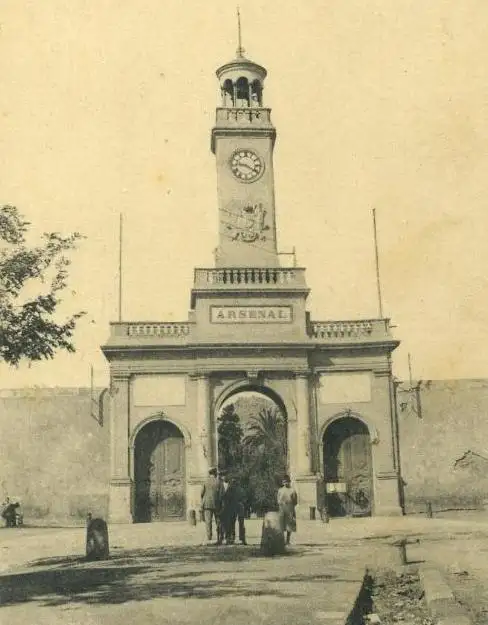
Access to the Arsenal de Cartagena, where one of the three Academies of the Spanish Navy is established in 1977.
It was common for each commander to be surrounded by four young people who were routinely educated on board and who, by the force of years, navigating and fighting acquired the experience, not always enough, that through successive appointments he entrusted to them the command of bass and even squads. The senists had already appeared, the ones applied to the mockery of the most foolish who assured that since there had been lower breasts had been lost, and Patiño, with his fine creative instinct, was able to put himself on the side of those creating an academy and a plan with gallid scientific bases, disdain what in his way worked in Cartagena for the Standard Guardsthat came to be the Marines of the Galeras already decadent. Some young people went to study in France (the famous Don Blas de Lezo was one of them), but the French orgarization left much to be desired, and although the Gardes de la Marine they were recruited among the nobility of the country, their school went through real moments of abandonment and little of it could be copied. The English, although already almost predominant at sea, formed their officers from small children with even merchant captains, without great technique or discipline, even with much experience and technique of the sea. Patiño thought to educate the noble youth by using it for the Navy and adopted a mixed system between the French and the English formula. In late 1716 the idea of the creation of Marine Guards Company in our Navy was a determined issue, and letters were given to the various maritime provinces with instructions on the choice of future cadets.
The early days
The call to the service of the Royal Navy to the most flourishing of the youth of the Spanish nobility had immediate response and on February 7, 1717 a first group of thirty and seven knights was formed. The first seat in the company's master book is the Prince of Yache, the first-born son of the Prince of Campo Florido, governor and captain general of the province of Guipúzcoa. The group of marine guards sailed from Pasajes, aboard the ships San Luis, San Fernando, San Pedro and San Juan Bautista, which rallied to Cadiz, where they landed the marine guards to house their academy and inn in the houses of the Villavicencio, in the district of Pópulo (in the vicinity of the present City Hall), where they constituted the Royal Marine Guard Company. Your first
It was written by Patiño and was composed of 99 articles that were to have the force of ordinances. The first one said:"The Marine Guard Company must be composed of a capitan, a lieutenant and a ensign, and must be the brigade to more than 50 Marine Guards who must have each one Brigadier and two Sub- Brigadier. The circumstances that a Guardin Marin must have to be admitted is that of being a Hypocalgo to use Spain or son of captain". In order to attend to the instruction of the young, an academy was formed consisting of a first master director who was subordinate to the remaining teachers in number of nine. The main subjects were: Mathematics, Nautics, Artillery and Manifery, with the complementary language, drawing, tactic, fencing and dance. The first captain of the Company was Brigadier Don Luis Dormay.
From San Fernando to Marín
In Cadiz was the Marine Guard Company until 1769, which moved to the Casa del Sacramento in San Fernando. In 1776 it is established that each of the three maritime departments has it, so the following year the ones of Ferrol and Cartagena are opened. The War of Independence paralyzed the academies and their students passed to the Navy and Army Corps battalions. After the fight, only the activity of San Fernando's was recovered, moving in 1824 to La Carraca. In 1845, the Military Naval College of San Carlos was established, which came to be governed in a similar way to that of the former Company and was still entered by grace, but in the new class of Marina seekers. The 1868 revolution brought with it the closure of the Naval College, giving way to the Floating Naval School on board the Fragata Asturias, under the command of Victoriano Sánchez Barcáiztegui, founded in La Graña (Ferrol).

Image of the opening parade of the Military Naval School. The events were presided over in Marín by the Head of State, who was accompanied by the then Minister of Marina, Don Salvador Moreno.
In 1912, the foundation for the constitution of the Miltar Naval School was approved, which was opened the following year in the old building of the San Carlos Naval College, where it remained until 1943 in which it moved to its current site in Marin, on which it was the School of Artillery and Tyre Naval Janer. The decision to transfer to Marín was made in 1939, being Minister of Marina Don Salvador Moreno and Fernández. They were certainly the first reasons that determined this transfer, but certainly among them they would not fail to include the magnificent geographical conditions of the ría, spatiosity, the cleaning of their funds, as well as the coat and the security of the port, considered from very old as one of the most preferred natural anchorages of the navigators among all the rest of the low rías.
The works began in the same year of 1939 and were completed on August 15, 1943, when with extraordinary brilliance took place the inauguration presided over by the Head of State. He was his first director at that time, the ship captain Don Pedro Nieto Antúnez.
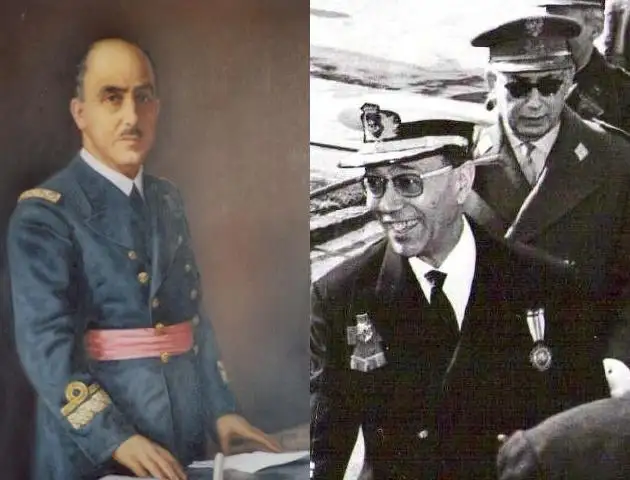
Admiral Don Salvador Moreno and the first Commander-in-Chief who reached the Admiralty and was also Minister of Navy: Don Pedro Nieto Antúnez.
From the beginning, the Navy has sought to improve and update the facilities in order to avoid the defaulting of the teaching media with the new techniques in use on board ships. Throughout the history of the Naval School the curricula will have been more or less extensive, practical or technical, but what does not vary is the rigid, as well as the family, discipline and love without limits to the Spanish Homeland. Only in the periods of greatness, ambition and open perspectives did Spain have its collective look and national illusion placed at sea. Without Naval Power there is no Patria fortress.
Carlos Sande Amor (Captain of Christmas-R)
© 2024 Nautica Digital Europe - www.nauticadigital.eu


